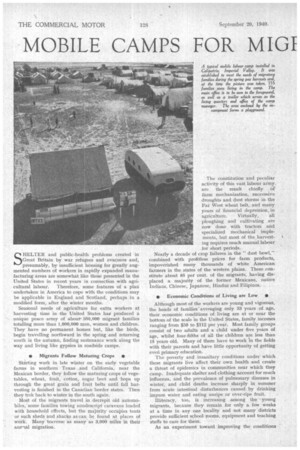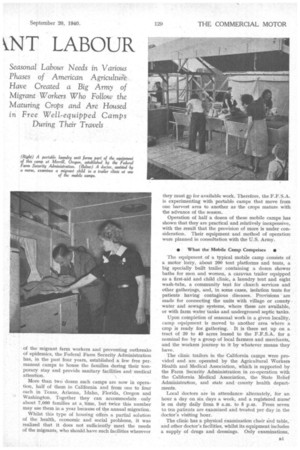MOBILE CAMPS FOR MIGI NT LABOUR
Page 26

Page 27

Page 28

If you've noticed an error in this article please click here to report it so we can fix it.
Seasonal Labour Needs in Various Phases of American Agriculture Have Created a Big Army of Migrant Workers Who Follow the Maturing Crops and Are Housed in Free Well-equipped Camps During Their Travels SHELTER and public-health problems created in Great Britain by war refugees and evacuees and, presumably, by insufficient housing for greatly augmented numbers of workers in rapidly expanded manufacturing areas are somewhat like those presented in the United States in recent years in connection with agricultural labour. Therefore, some features of a plan undertaken in America to cope with the conditions may be applicable in England and Scotland, perhaps in a modified form, after the winter months. .
Seasonal needs of agriculture for extra workers at harvesting time in the United States has produced a unique peace army of about350,000 migrant families totalling more than 1,000,000 men, women and children. They have no permanent homes but, like the birds, begin travelling northward in the spring and returning south in the autumn, finding sustenance work along the way and living like gypsies in roadside camps.
• Migrants Follow Maturing Crops • Starting work in late winter on the early vegetable farms in southern Texas and California, near the Mexican border, they follow the maturing crops of vegetables, wheat, fruit, cotton, sugar beet and hops up through the great grain and fruit belts until fall harvesting is finished in the Canadian border states. Then they trek back to winter in the south again.
Most of the migrants travel in decrepit old automobiles, some families towing nondescript caravans loaded with household effects, but the majority occupies tents • or such sheds and shacks as can be found at places of • work. Many traverse as many as 3,000 miles in their antrtal migration. The constitution and peculiar activity of this vast labour army. are the result chiefly of farm mechanization, successive droughts and dust storms in the Far West wheat belt, and many years of financial depression, in agriculture. Virtually, all ploughing and cultivating are now done with tractors and specialized mechanical implements, but most of the harvesting requires much manual labour for short periods.
Nearly a decade of crop failures in the " dust bowl," combined with profitless prices for farm products, impoverished many thousands of white American farmers in the states of the western plains. These constitute about 85 per cent, of the migrants, having displaced a majority of the . former Mexicans, native Indians, Chinese, Japanese, Hindus and Filipinos.
• Economic Conditions of Living are Low • Although most of the workers are young and vigorous, the heads of families' averaging only 33 years of age, their economic conditions of living are at or near the bottom of the scale in the United States, family incomes ranging from $50 to $112 per year. Most family groups consist of two adults and a child under five years of age, whilst four-fifths of all the children are less than 15 years old. Many of them have to work in the fields with their parents and have little opportunity of getting even primary education.
The poverty and insanitary conditions under which these migrants live affect their own health and create a threat of epidemics in communities near which they camp. Inadequate shelter and clothing account for much influenza, and the prevalence of pulmonary diseases in winter, and child deaths increase sharply in summer from acute intestinal disturbances caused by drinking impure water and eating unripe or over-ripe fruit.
Illiteracy, too, is increasing among the young migrants, because they remain for only a few weeks at a time in any one locality and not many 'districts provide sufficient school -rooms, equipment and teaching staffs to care for them.
As an experiment toward improving the conditions of the migrant farm workers and preventing outbreaks of epidemics, the Federal Farm Security Administration has, in the past four years, established a few free permanent camps to house the families during their temporary stay and provide sanitary facilities and medical attention.
More than two dozen such camps are now in operation, half of them in California and from one to four each in Texas, Arizona, Idaho, Florida, Oregon and Washington. Together they can accommodate only about 7,000 families at a. time, but twice this number may use them in a year because of the annual migration.
Whilst this type of housing offers a partial solution of the health, economic and social problems, it was realized that it does not sufficiently meet the needs of the migrants, who should have such facilities wherever they must g,o for available work. Therefore, the F.F.S.A. is experimenting with portable camps that move from one harvest area to another as the crops mature with the advance of the season.
Operation of half a dozen of these mobile camps has shown that they are practical and relatively inexpensive, with the result that the provision of more is under consideration. Their equipment and method of operation were planned in consultation with the U.S. Army.
• What the Mobile Camp Comprises •
The equipment of a typical mobile camp consists of a motor lorry, about 200 tent platforms and tents, a big specially built trailer containing a dozen shower baths for men and women, a caravan trailer equipped as a first-aid and child clinic, a laundry tent and eight wash-tubs, a community tent for church services and other gatherings, and, in some cases, isolation tents for patients having contagious diseases. Provisions are made for connecting the units with village or county water and sewage systems, where these are available, or with farm water tanks and underground septic tanks.
Upon completion of seasonal work in a given locality, camp equipment is moved to another area where a crop is ready for gathering. It is there set up on a tract of 20 to 40 acres leased to the F.F.S.A. for a nominal fee by a group of local farmers and merchants, and the workers journey to it by whatever means they have
The clinic trailers in the California camps were provided and are operated by the Agricultural Workers Health and Medical Association, which is supported by the Farm Security Administration in co-operation with the California Medical Association, the State Relief Administration, and state and county health departments.
Local doctors are in attendance, alternately, for an hour a day on six days a week, and a registered nurse' is on duty daily from 9 a.m. to 5 p.m. From seven to ten patients are examined and treated per day in the doctor's visiting hour.
The clinic has a physical examination chair and table, and other doctor's facilities, whilst its equipment includes a supply of drugs and dressings. Only examinations, diagnoses and treatment of minor ailments and injuries are performed. The chief value of the clinic is for preventive service, early diagnosis, vaccination and innoculation against contagious diseases, and prompt attention to illnesses and injuries that might become serious if neglected.
A camp manager has his living quarters and an office in a caravan which forms a unit of the mobile camp.
No one can foretell the future of such mobile camps. They are under trial as an emergency measure to help mitigate deplorable conditions which are thought to be temporary for, at least, a considerable proportion of the unfortunates.
Migratory farm labour seems likely, however, to be a permanent feature of the national economy. Its extent has been growing for many years, largely because of farm mechanization. The expansion of this movement is indicated by the fact that, in from 1920 to 1937, the number of farm tractors in use in the state of Texas increased from 9,000 to about 99,000.
Growing national social consciousness and importance of public-health protection will, for years to come, demand adequate shelter, sanitary facilities and medical attention for upwards of 1,000,000 itinerant farmhands. and at least primary education for about a quarter as Many of their children of school age.
Mobile camps appear to be the most practicable way of dealing with the problem in the harvesting months, and it may well be that in a few years this great labour army will travel and camp very much as the nation's military forces move and live during their manceuvres.
The normal, traditional, efficient American way, however, would be for private contractors to provide the equipment, move and operate the camps as a circus is handled, hire crews of workers on regular wages or on a piecework basis, and contract with farm owners to harvest the crops at an overall figure, or for a stated price per gathered measure. That would relieve Government agencies of the burden, raise the morale of the workers by removing the present element of charity, assure a dependable supply of labour at the time needed, and transfer direction and supervision from the farmer to an experienced and thoroughly competent labour crew manager. H.W.P.




























































